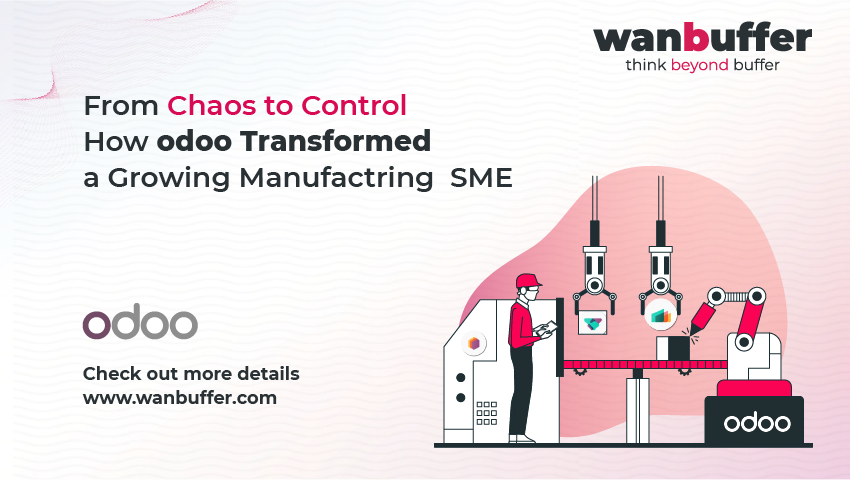
Table of Contents
1. Introduction
As manufacturing SMEs grow, so do their complexities. From tracking raw materials and managing production schedules to ensuring timely deliveries, small and mid-sized manufacturers often struggle with fragmented systems and manual processes.
This case study shares how a fast-growing manufacturing SME went from operational chaos to streamlined control by implementing Odoo ERP—with support from Wan Buffer Services.
2. Challenges Faced by the Manufacturing SME
- Disconnected systems for inventory, sales, and production
- Inaccurate stock levels causing delays and overstocking
- Manual order processing leading to frequent human errors
- No real-time visibility into production status
- Lack of coordination between departments
Without a centralized system, they were spending more time fixing problems than producing goods.
3. Why Odoo Was Chosen
- Its modular and scalable architecture
- Seamless integration between different business functions
- User-friendly interface that reduced training time
- Affordability for SMEs without sacrificing features
- Flexibility to adapt the platform for manufacturing needs
Partnering with Wan Buffer Services, they began a structured ERP transformation journey.
4. Key Modules Implemented
- Inventory Management: For real-time stock tracking and warehouse optimization
- Manufacturing (MRP): To manage BOMs, production orders, and work centers
- Sales & Purchase: To automate quotations, procurement, and vendor relations
- Accounting: For synchronized financials and real-time profitability tracking
- CRM & Helpdesk: For managing leads, orders, and after-sales service
All modules were customized to fit the SME’s unique manufacturing workflows. Learn more.
5. Operational Improvements Post-Odoo
- 80% reduction in manual data entry across departments
- Automated inventory alerts prevented overstocking and shortages
- Real-time production tracking enabled better resource planning
- Sales teams could access live inventory and production status
- Procurement was based on smart demand forecasting
The integrated platform improved cross-functional collaboration, leading to faster decision-making.
6. Measurable Business Impact
- Inventory accuracy improved from 65% to 96%
- Order processing time dropped by 50%
- Production delays were reduced by 60%
- Monthly sales increased by 20% due to faster order cycles
- Customer satisfaction scores rose by 30%
These metrics highlighted the return on investment and laid the foundation for further expansion.
7. Lessons Learned and Best Practices
- Start with a clear roadmap: Identify business priorities before choosing modules
- Train teams early: User adoption plays a critical role in ERP success
- Customize only when needed: Leverage Odoo’s built-in capabilities before adding custom code
- Work with experts: A trusted implementation partner like Wan Buffer Services ensures best practices are followed
8. Conclusion
For growing manufacturing SMEs, the journey from chaos to control is possible—with the right ERP system in place. Odoo’s flexible, modular platform enabled this SME to unify its operations, reduce inefficiencies, and drive measurable growth.
If your manufacturing business is ready to scale with confidence,
Contact Wan Buffer Services today to discover how Odoo can transform your operations.
9. FAQs
-
Q1: Is Odoo suitable for small manufacturers with complex processes?
Absolutely. Odoo’s modular nature makes it highly adaptable, even for smaller firms with specialized manufacturing needs. -
Q2: How long does it take to implement Odoo for a manufacturing SME?
A basic implementation can take 8–12 weeks, but the timeline depends on the complexity and customization required. -
Q3: Can Odoo integrate with machines or shop-floor systems?
Yes. With the right connectors and APIs, Odoo can integrate with IoT devices, barcode scanners, and production machinery.

